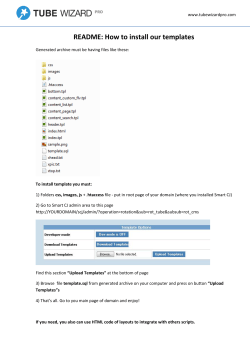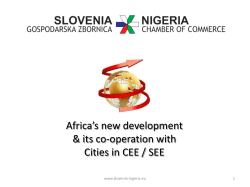
Tropentag 2014, Prague, Czech Republic September 17-19, 2014
Tropentag 2014, Prague, Czech Republic September 17-19, 2014 Conference on International Research on Food Security, Natural Resource Management and Rural Development organised by the Czech University of Life Sciences Prague Cocoyam Root Rot Disease caused by Pythium myriotylum in Nigeria Feyisara Olorunlekea, Amayana Adiobob, Joseph T. Onyekac, Monica Höftea* a Ghent University, Phytopathology Laboratory, Department of Crop Protection, 9000 Ghent, Belgium. b Institute for Agricultural Research for Development (IRAD) Ekona, Biotechnology Laboratory, Cameroon. c National Root Crops Research Institute (NRCRI), Plant Pathology Unit, Nigeria. * Corresponding author. Email: monica.hofte@ugent.be Introduction In Nigeria, cocoyam (Xanthosoma sagittifolium) is an important staple which besides being a food crop, serves as a major source of income for rural households. Yield losses due to cocoyam root rot disease (CRRD) remains a major constraint to increased cocoyam production in Nigeria. Until now, this disease has been attributed to a pathogen complex including Fusarium solani and Rhizoctonia solani. However, symptoms observed in infected fields in Nigeria are similar to those caused by the oomycete, Pythium myriotylum, on diseased cocoyam plants in Cameroon and Costa Rica (Pacumbamba et al. 1992; Perneel et al. 2006). Thus, the aim of this study was to determine the primary causal pathogen of CRRD disease in Nigeria. Material and Methods Field sampling and Pathogen Isolation Diseased cocoyam plants from an infected field at the National Root Crops Research Institute, Umudike, Nigeria, were collected and brought to the Plant Pathology Lab of the Institute. Roots were thoroughly washed in running tap water until white and examined for light brown spots. These spotted sections were then excised and rinsed with distilled water. Under sterile conditions, excised roots were surface sterilized using 1% NaOCl for 15 min and transferred onto sterilized water agar medium (15g agar L-1 of water) supplemented with streptomycin sulphate (0.3g/L) in sterile 90 mm Petri dishes. Streptomycin sulphate was added after autoclaving. Plates were incubated at 28°C for 48 h. Actively growing hyphal tips were transferred aseptically to antibiotic-free water agar and incubated under similar conditions. Following this, isolates obtained were subcultured on PDA plates and examined 2-3 days later. Molecular identification of the Pathogen The rDNA-ITS region of two collected isolates were sequenced. These isolates were grown on Potato dextrose broth for 3 days after which mycelial mats were harvested by filtration and ground to a fine powder with liquid nitrogen. DNA extraction was carried out using the DNeasy Plant Mini Kit (Qiagen). The rDNA-ITS fragment was amplified using the primers ITS4 (5’TCCTCCGCTTATTGATATGC-3’) and ITS5 (5’-GGAAGTAAAAGTCGTAACAAGG-3’). DNA was amplified by PCR in a 25µl mixture containing 2µl genomic DNA, 2.5µl PCR buffer 1 (10x; Qiagen), 5µl Q-solution (Qiagen), 0.5µl dNTPs (10mM; Fermentas GmbH), 1.75 µl of each primer (10µM), 0.15 µl Taq DNA Polymerase (5 U µl-1; Fermentas GmbH), and 11.35µl of sterile water. Amplication was performed using Flexcycler PCR Thermal Cycler with initial denaturation of 94°C for 10 min followed by 35 cycles of 94°C for 1 min, 55°C for 1 min, 72°C for 1 min, and a final extension at 72°C for 10 min. Amplification products were separated on 1% agarose gel in TAE buffer at 100V for 25 min and visualized by ethidium bromide staining. Genomic sequences were determined using Sanger Sequencing by LGC Genomics GmbH (Berlin, Germany). Pathogenicity Tests Based on morphological characteristics and ITS sequence homology with P. myriotylum isolates which are pathogenic to cocoyam roots, P. myriotylum NGR02 and NGR03 were selected for pathogenicity assays. Pathogenicity tests were carried out in conducive volcanic soil collected from Molyko, a cocoyam growing area of Cameroon. The soil used for the experiment was sterilized twice. Isolates were grown on PDA plates for 5 days at 28°C and three plugs of each isolate were used to infect 300 ml of soil. Mycelial plugs of inoculum were blended in 300ml sterile distilled water after which the inoculum suspension was mixed with the soil. Subsequently, 6-8 week-old tissue-culture cocoyam plantlets produced as described by Tambong et al. (1998) were transplanted into each plastic box containing the inoculum-soil mixture. The experimental set-up was a completely randomized design with ten cocoyam plantlets per treatment, including a healthy control. Each cocoyam plant had at least 3 leaves. The transplanted plantlets were incubated at 28°C ± 2°C and hand-irrigated daily to maintain moisture content of the soil. Plants were observed daily for typical symptoms of the cocoyam root rot disease. The root rot severity was scored using a rating scale 0 (no symptom) to 4 (death of leaf) as described by Tambong et al. (1999) with minor modifications. The experiment was repeated thrice. Isolates NGR02 and NGR03 were successfully re-isolated from infected roots and characterized. Data analysis Consensus sequences of NGR02 and NGR03 were obtained using BioEdit version 7.1.11. These sequences were compared to those in the Genbank using the BLASTn tool. For the pathogenicity experiments, the disease index was calculated as: Disease Index = ∑ (Disease class x number of leaves within that class) Total number of plants within treatment x highest class value in the scale Results and Discussion Morphological and Molecular Characterization of Isolates Isolates NGR02 and NGR03, isolated from cocoyam roots in Nigeria were identified as Pythium myriotylum on the basis of morphological characteristics including a typical powdery appearance on PDA medium and subsequent fluffy appearance of the mycelium after 3 days (Figure 1). The ITS regions of these isolates were amplified by PCR, sequenced and analyzed. The sequences of NGR02 and NGR03 both showed 99-100% homology to P. myriotylum isolates obtained from Cameroon and Costa Rica which are severely pathogenic on cocoyams (Perneel et al. 2006). Pathogenicity Tests The two isolates were evaluated for pathogenicity to cocoyam tissue culture-derived plantlets. Root rot symptoms were observed 3 days after inoculation (Figure 1) and the leaves were scored 2 10 days post inoculation using a scoring system ranging from no disease (class 0) to leaf death (class 4). Figure 2A shows severe symptoms of the root rot disease which include yellowing of leaves and death of the plant in some cases while Figure 2B shows below-ground root rot symptoms caused by the test pathogens in comparison with the healthy control. Isolates NGR02 and NGR03 were again isolated from infected roots and showed similar characteristics as previously observed. A. B. Figure 1: Fluffy mycelium of P. myriotylum on PDA plates after 4 days A) NGR02 and B) NGR03. Control NGR02 Control NGR03 A. NGR02 NGR03 B. Disease Index (%) Figure 2: Pathogenicity experiments using NGR02 and NGR03 on tissue-cultured cocoyam plantlets. A) yellowing and death of cocoyam leaves caused by isolates and, B) root rot disease symptoms. 100 90 80 70 60 50 40 30 20 10 0 b b b b NGR02 NGR03 a a Control Repetition I Repetition II Treatments Figure 3: Pathogenicity of NGR02 and NGR03 on tissue-culture derived cocoyam plantlets. Bars with different letters are statistically different at 5% probability level using the Mann Whitney test Furthermore analysis of the disease index calculated from the data did not reveal a statistical difference between NGR02 and NGR03. This was consistent in both repetitions (Figures 3). In 3 Diseased Leaves/Treatment (%) Experiment I 100 90 80 70 60 50 40 30 20 10 0 Control NGR02 NGR03 Treatments Diseased Leaves/Treatment (%) addition to this, there was no observed difference in virulence when the percentage of diseased leaves in both isolates was compared. In the first experiment, almost all diseased leaves were scored as classes 3 and 4 for both isolates except a few leaves which were scored as class 2 in the NGR03 treatment. However, the second experiment showed a distribution of all diseased leaves across classes 2, 3 and 4 for both isolates (Figures 4). Experiment II 100 90 80 70 60 50 40 30 20 10 0 Class 4 Class 3 Class 2 Class 1 Class 0 Control NGR02 NGR03 Treatments Figure 4: Pathogenicity of NGR02 and NGR03 on tissue-culture derived cocoyam plantlets according to classes Conclusions and Outlook This study demonstrates that Pythium myriotylum isolates that infect cocoyam in Nigeria are similar to the isolates which infect cocoyam in Cameroon and Costa Rica. The two isolates obtained also appear to be similar in virulence. This knowledge puts an end to uncertainties about the causal pathogens attributed with this disease in Nigeria and will enable future focus on disease management strategies. References Pacumbamba, R. P., Wutoh, J. G., Eyango, S. A., Tambong, J. T., and Nyochembeng, L. M. (1992). Isolation and pathogenicity of rhizosphere fungi of cocoyam in relation to cocoyam root rot disease. Journal of Phytopathology, 135: 265-273. Perneel, M., Tambong, J. T., Adiobo, A., Floren, C., Saborio, F., Levesque, A., and Höfte, M. (2006). Intraspecific variability of Pythium myriotylum isolated from cocoyam and other host crops. Mycological Research 110: 583-593. Tambong, J. T., Poppe, J., and Höfte, M. (1999). Pathogenicity, electrophoretic chatracterization and in planta detection of the cocoyam root rot disease pathogen, Pythium myriotylum. European Journal of Plant Pathology, 105: 597-607. Tambong, J. T., Sapra, V. T., and Garton, S. (1998). In vitro induction of tetraploids in colchiline-treatedcocoyam plantlets. Euphytica, 104: 191-197. 4
© Copyright 2025
















